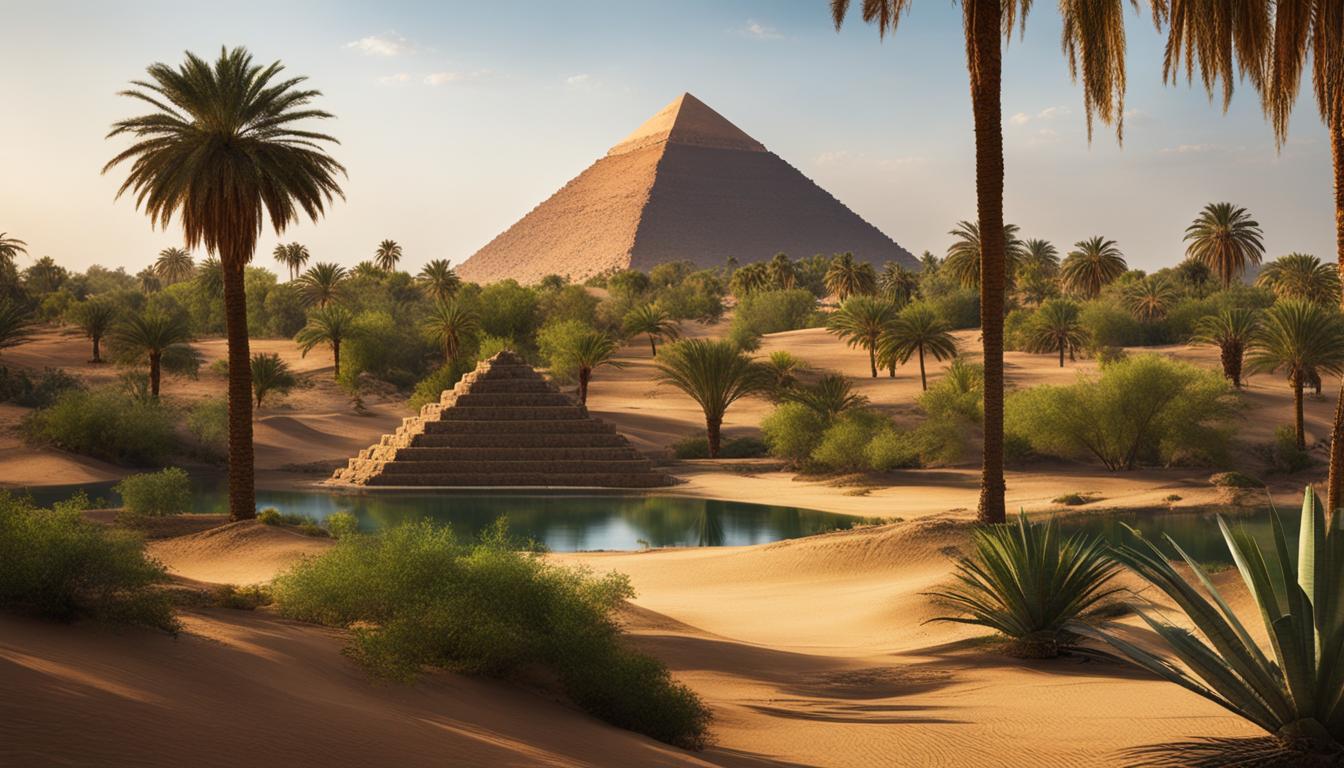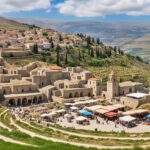The Bible is filled with historical places that hold immense religious and cultural significance. These biblical landmarks, ancient cities, and sacred locations play a pivotal role in the stories and teachings found within the pages of the Bible. They provide a glimpse into the rich history of the biblical world and continue to be revered by millions of people worldwide.
Key Takeaways:
- Biblical landmarks and holy sites in the Bible are of great importance to religious and cultural history.
- These sacred locations offer a deeper understanding of the stories and teachings in the Bible.
- Ancient biblical cities and religious landmarks have significant historical and archaeological value.
- Visiting these notable biblical places can be a transformative experience for those seeking to connect with their faith.
- The Bible holds a wealth of information about these historic biblical sites and their significance.
Tel Megiddo: The Site of the Final Battle
Tel Megiddo, also known as Armageddon, is a site located in Israel with great biblical significance. It is believed by some Christians to be the site of the end-times battle prophesied in the Book of Revelation. Archaeologists have discovered 26 layers of human occupation at this site, indicating its long history. Tel Megiddo was an important city during the Bronze Age and later became a royal city in the Kingdom of Israel according to the Hebrew Bible.
Throughout history, Tel Megiddo has played a significant role in the region. Its strategic location on a hilltop overlooking the Jezreel Valley made it an important military and trade hub. The ruins of the Canaanite city and subsequent Israelite settlements provide valuable insights into the ancient world.
The biblical association of Tel Megiddo with the end-times battle has given rise to various interpretations and speculations. The Book of Revelation describes a climactic battle between good and evil that is said to take place at Armageddon, which is often associated with Tel Megiddo. While the precise nature of this battle remains a subject of religious debate, Tel Megiddo continues to captivate the imagination of scholars and believers alike.
“And they gathered them together to the place called in Hebrew, Armageddon.” – Revelation 16:16
The archaeological findings at Tel Megiddo provide a glimpse into the ancient world and offer valuable insights into the history and culture of the region. The layers of human occupation reveal a multi-layered society with various influences and traces of successive civilizations.
Understanding the significance of Tel Megiddo requires examining its historical context. As a Canaanite city, it witnessed the rise and fall of empires, military conquests, and cultural transformations. The Kingdom of Israel’s control over Tel Megiddo during the Iron Age further solidifies its biblical connections.
Visiting Tel Megiddo offers a unique opportunity to explore the remnants of an ancient city and witness firsthand the archaeological discoveries that have shaped our understanding of biblical history. The site’s breathtaking views of the surrounding landscape only enhance the experience, transporting visitors back in time.
Summary:
Tel Megiddo, also known as Armageddon, is a site in Israel that holds great biblical significance. It is believed to be the location of the end-times battle prophesied in the Book of Revelation. With its rich history and archaeological findings, Tel Megiddo offers a unique insight into the ancient world and the biblical narrative. Exploring this site allows visitors to connect with the past and gain a deeper understanding of the Kingdom of Israel and the Canaanite city that once stood on this hallowed ground.
| Key highlights: | Location: | Significance: |
|---|---|---|
| End-times battle site | Israel | Biblical and archaeological |
| 26 layers of human occupation | Overlooking Jezreel Valley | Religious and historical importance |
| Important city during Bronze Age | Strategic military and trade hub | Insights into ancient civilizations |
| Significance in the Kingdom of Israel | Captivating religious symbolism | Gateway to the past |
Qumran: Discovering the Dead Sea Scrolls
Located in Israel’s West Bank, Qumran is renowned for its association with a momentous archaeological find – the Dead Sea Scrolls. Discovered in nearby caves, these ancient Hebrew and Aramaic texts contain invaluable insights into biblical text and other ancient writings. Qumran is widely believed to have been the home of the Essenes, a Jewish sect closely associated with the authorship of the Dead Sea Scrolls. Extensive excavations have revealed the ruins of buildings and a complex aqueduct system, shedding light on the practices and way of life of this ancient community.

Significance of the Dead Sea Scrolls
The discovery of the Dead Sea Scrolls at Qumran has had a profound impact on our understanding of biblical text and ancient writings. These manuscripts, dating back over 2,000 years, include copies of almost every book in the Hebrew Bible, offering valuable parallels and variant readings. They provide a unique glimpse into the religious beliefs, practices, and historical context of the time.
“The Dead Sea Scrolls are an unparalleled treasure trove of biblical and ancient texts that have revolutionized our understanding of the Bible and the history of Judaism and Christianity.” – Professor Lawrence Schiffman
The Essenes: Keepers of the Scrolls
The discovery of the Dead Sea Scrolls has shed light on the possible role of the Essenes in preserving and copying biblical texts. The Essenes were an ascetic Jewish sect that sought spiritual purity and withdrew from mainstream society. Qumran’s location in proximity to the caves where the scrolls were found has led scholars to associate the Essenes with their authorship or custodianship. The scrolls highlight the theological perspectives and practices of this influential community.
| Key Discoveries at Qumran | Significance |
|---|---|
| Ruins of Buildings | Provide insights into the Essene lifestyle and communal structures. |
| Complex Aqueduct System | Indicates advanced engineering skills and a sophisticated understanding of water management. |
| The Dead Sea Scrolls | Offer invaluable biblical and ancient texts, expanding our knowledge of religious practices and historical context. |
Exploring Qumran and the Dead Sea Scrolls is like taking a step back in time, immersing oneself in the ancient world of biblical text and the intriguing lives of the Essenes. The discoveries at Qumran continue to captivate scholars and visitors alike, deepening our understanding of the rich tapestry of religious and cultural history.
Tel Hazor: Joshua’s Conquest
Tel Hazor, located in Israel’s Galilee region, is believed to be the biblical town of Hazor. According to the Old Testament, this ancient city was the site of a significant battle during Joshua’s conquest of Canaan.
Excavations at Tel Hazor have unearthed compelling evidence of burned materials and structures, indicating a violent event took place. These findings align with the biblical account of Joshua’s conquest and the destruction of Hazor.
However, there is ongoing debate among archaeologists regarding the authenticity of the biblical battle at Tel Hazor. Some scholars propose alternative theories, suggesting that the destruction may have been caused by natural disasters or internal conflicts.
“Tel Hazor stands as a witness to the power struggles of ancient times, and its excavation offers tantalizing insights into the biblical narrative.” – Dr. Rachel Kahan, Archaeologist
To gain a better understanding of the site’s significance, let’s explore a table summarizing the key details:
| Site Name | Description | Biblical Reference |
|---|---|---|
| Tel Hazor | An ancient city located in Israel’s Galilee region. | Joshua 11:10-11 |
| Joshua’s Conquest | The military campaign led by Joshua to capture and occupy the land of Canaan. | Joshua 11:21-23 |
| Biblical Battle | Key victory during Joshua’s conquest, involving the destruction of Hazor. | Joshua 11:10-13 |

Tel Hazor serves as an intriguing archaeological site, shedding light on the biblical narrative and the historical events that shaped the region. The ongoing research and excavation efforts at Tel Hazor continue to provide valuable insights into ancient Canaanite culture, the biblical battle, and the conquest of the Promised Land.
Machaerus: The Imprisonment of John the Baptist
Machaerus, located in Jordan, is an ancient fortress that holds significant historical and biblical importance. Originally built by Herod the Great, this fortress served as a military base during his reign. However, it is most famously known as the place where John the Baptist was imprisoned and executed.
According to the accounts in the Bible and Jewish historian Flavius Josephus, Herod Antipas, the son of Herod the Great, ordered the imprisonment and execution of John the Baptist in Machaerus. John the Baptist, a prominent figure in Christian and biblical teachings, was known for his ministry of baptism and his role in preparing the way for Jesus.
“From that time on, Herod Antipas began to covet his brother’s wife, Herodias, and plot against John the Baptist, ultimately leading to his imprisonment and execution at the fortress of Machaerus.” – Flavius Josephus
Machaerus stands as a testament to the events and figures that shaped biblical history. This site serves as a pilgrimage destination for those seeking to connect with the stories and teachings of John the Baptist, as well as the broader biblical narrative.

Next in our journey through the historical places of the Bible, we’ll explore a holy land shrouded in both reverence and controversy: the Old City of Jerusalem.
Old City of Jerusalem: A Holy and Contested Land
The Old City of Jerusalem is a place of profound religious significance for Jews, Christians, and Muslims. It is a walled compound that encapsulates centuries of history, faith, and cultural heritage. Within its walls, visitors can explore iconic religious sites that are revered by millions worldwide.
At the heart of the Old City is the Temple Mount, a site of immense importance to Jewish tradition. It is believed to be the place where God created the first human according to Genesis, and where Solomon built the grand First Temple. Today, the Temple Mount is adorned with two remarkable Islamic structures: the Dome of the Rock and the al-Aqsa Mosque. These architectural marvels serve as important symbols of Islamic faith and draw Muslims from all corners of the globe.
The Dome of the Rock is an iconic golden-domed shrine that enshrines the sacred rock where Muslims believe Muhammad ascended to heaven. Its intricate mosaics and intricate calligraphy make it a breathtaking sight for visitors. The al-Aqsa Mosque, the third holiest site in Islam, is a sprawling complex that holds deep spiritual resonance for Muslims.
The Old City is also home to the Church of the Holy Sepulchre, one of Christianity’s most venerated sites. This ancient church is believed to be the location of Jesus’ crucifixion, burial, and resurrection. Pilgrims from all Christian denominations visit the church to pay their respects and seek spiritual enlightenment.
The Western Wall, also known as the Wailing Wall, is a section of the ancient retaining wall of the Second Temple. It stands as a poignant reminder of the Jewish heritage and is a place of prayer and reflection for Jews. Visitors can observe firsthand the emotional connection and reverence that Jews have for this sacred site.
Despite its immense religious significance, the Old City of Jerusalem has also been a center of conflict and political tension for decades. Its complex history and contested ownership have been the subject of numerous disputes between Israeli and Palestinian authorities.

The Old City of Jerusalem continues to be a captivating destination for those seeking a profound spiritual experience and a deeper understanding of the interconnectedness of different religious traditions. It serves as a testament to the diversity and coexistence of various faiths.
Tel Beersheba: Abraham’s Well
Tel Beersheba, located in the Negev desert of southern Israel, is an archaeological site that is believed to be the remains of the biblical town of Beersheba. This ancient city holds significant historical and biblical importance, particularly in relation to the patriarch Abraham and his dealings with the Philistine King Abimelech.
According to the Old Testament, Abraham negotiated a deal with King Abimelech over a well at Tel Beersheba. This negotiation is recounted in Genesis 21:25-31, where Abraham confronts Abimelech about a disputed well that the king’s servants had seized. After resolving their differences, the two leaders entered into a treaty, marking the significance of the well as a symbol of peace and stability.
“And Abraham reproached Abimelech because of a well of water, which Abimelech’s servants had violently taken away. And Abimelech said, I wot not who hath done this thing; neither didst thou tell me, neither yet heard I of it, but today. And Abraham took sheep and oxen, and gave them unto Abimelech; and both of them made a covenant.”
In addition to its historical and biblical significance, Tel Beersheba also contains a remarkable water system of cisterns that date back to the Iron Age. These cisterns were essential in providing water to the ancient inhabitants of the city, highlighting their resourcefulness and the importance of water management in ancient times.
Visiting Tel Beersheba offers a unique opportunity to explore the remnants of an ancient biblical town and walk in the footsteps of Abraham. It provides a tangible connection to the stories and events described in the Bible, allowing visitors to gain a deeper understanding of the historical and cultural context in which these events took place.
Key Highlights of Tel Beersheba:
- The remains of the biblical town of Beersheba
- A well associated with the negotiation between Abraham and King Abimelech
- Well-preserved water cisterns from the Iron Age
Mount Nebo: Moses’ Final View
Located in Jordan, Mount Nebo holds significant biblical and historical importance as the supposed place where Moses viewed the Promised Land before his death. It is also believed to be his burial site, making it a revered destination for pilgrims and religious travelers.
The mesmerizing landscape of Mount Nebo offers visitors breathtaking views of the Holy Land and the Jordan River valley. Standing atop the mountain, one can gaze upon the land that Moses longed to enter but never set foot in. The view is a powerful reminder of the trials and sacrifices that marked the journey of the Israelites in their pursuit of the Promised Land.
For centuries, Mount Nebo has been a site of pilgrimage, attracting visitors from around the world who seek to connect with the deep spiritual significance of this place. The mountain is home to the ruins of a sixth-century church adorned with magnificent mosaics depicting scenes from the Bible, including Moses’ encounter with God and his glimpse of the Promised Land.
“And Moses went up from the plains of Moab to Mount Nebo, to the top of Pisgah, which is across from Jericho. Then the Lord showed him all the land of Gilead as far as Dan…” – Deuteronomy 34:1

Key Information about Mount Nebo
| Location | Country | Significance |
|---|---|---|
| Mount Nebo | Jordan | – Supposed place where Moses viewed the Promised Land – Believed to be Moses’ burial site – Home to a sixth-century church with biblical mosaics |
Conclusion
The Bible is a treasure trove of historical places that hold immense religious significance. These biblical landmarks and sacred locations offer a profound insight into the stories and teachings found within the pages of the Bible. From the legendary Tel Megiddo to the majestic Mount Nebo, each site unveils a captivating glimpse into the rich history and cultural heritage of the biblical world.
Exploring these bible places can be a transformative experience, allowing individuals to deepen their connection with their faith and gain a profound appreciation for the biblical narrative. Walking in the footsteps of ancient prophets, kings, and disciples provides a unique opportunity to witness firsthand the tangible remnants of the events and miracles described in scripture.
Whether it’s standing where the final battle is said to take place at Tel Megiddo or beholding the sweeping view of the Promised Land from Mount Nebo, these locations serve as a powerful testament to the enduring impact of the biblical stories. They remind us of the profound influence that faith, history, and culture have on shaping our understanding of the world we live in today.







